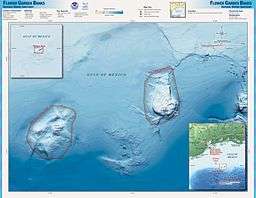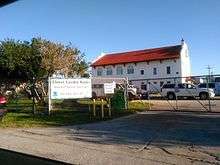Flower Garden Banks National Marine Sanctuary
| Flower Garden Banks National Marine Sanctuary | |
| Protected Area | |
 Map of Flower Garden Banks | |
| Country | United States |
|---|---|
| Region | Gulf of Mexico |
| Coordinates | 27°55′N 93°43′W / 27.917°N 93.717°WCoordinates: 27°55′N 93°43′W / 27.917°N 93.717°W[1] |

The Flower Garden Banks National Marine Sanctuary is a U.S. National Marine Sanctuary located 100 nautical miles (185 kilometers) offshore of Galveston, Texas in the northwestern Gulf of Mexico.
Underlying salt domes forced the seafloor upward in various areas of the Gulf of Mexico, resulting in the formation of rises and banks. Conditions of the Gulf of Mexico were conducive to reef-building, which started roughly ten to fifteen thousand years ago.
Two reefs, East Flower Garden Bank (EFGB) and West Flower Garden Bank (WFGB), made up Flower Garden Banks National Marine Sanctuary (FGBNMS) when it was initially created in 1992. In 1996, Stetson Bank was added to the sanctuary. The three banks are not contiguous.
The sanctuary contains many aquatic species. Almost three hundred species of fish and over twenty species of coral are found in the sanctuary along with a wide variety of crustaceans, sponges, and plants. FGBNMS provides habitat for many protected and/or threatened species including marine mammals, sharks, rays, and sea turtles. Many fish species important to recreational and commercial fisheries inhabit the banks.
History
The first recorded discovery of the areas comprising FGBNMS did not occur until 1936, when EFGB, WFGB, and Stetson Bank were included in a hydrographic survey of the Gulf of Mexico conducted by the U.S. Coast & Geodetic Survey. The survey provided valuable information about the geological and topographical characteristics of the banks. These initial surveys, along with additional surveys conducted in the 1950s, led researchers to conclude that the banks originated when salt domes forced overlaying sediments upward to form underwater mountains.
Dr. Thomas Pulley, Director Emeritus of the Houston Museum of Natural Science, led a team of professional and volunteer amateur explorers to investigate EFGB and WFGB in the early 1960s. The presence of coral reefs off the Texas coast was still being debated at that time. Some researchers predicted the area would be too cold, or too turbid to support any extensive coral reef development. These scuba diving explorations, however, revealed that EFGB and WFGB did indeed support extensive, pristine coral reef systems.[2]
In the late 1960s, Robert Alderdice and James Covington established the Flower Gardens Ocean Research center (FGORC), heralding a period of intense interdisciplinary research which continues to this day. Results of this on-going research prompted U.S. government agencies to begin discussing the need to protect the banks from increasing human activities, including oil and gas extraction, anchoring on the reefs, and harvesting fish, corals and other invertebrates. With passage of the Marine Research and Sanctuaries Act in 1972, researchers began discussing the Flower Garden Banks as a candidate for designation as a National Marine Sanctuary.
During the 1980s, recreational divers were also discovering the Flower Garden Banks. The Houston Underwater Club led a movement to have the banks officially designated as sanctuaries by submitting a formal letter of nomination in 1979. Due to a number of issues, eleven years passed before the Flower Garden Banks National Marine Sanctuary was officially established. President George H. W. Bush authorized Flower Garden Banks National Marine Sanctuary as the 10th National Marine Sanctuary on January 17, 1992. Stetson Bank was added to the sanctuary in 1996.
The Flower Garden Banks National Marine Sanctuary administrative offices and laboratories are located in a renovated historic building, a part of the former Fort Crockett, in Galveston, Texas. Research Vessel MANTA is also located in Galveston, and provides a working platform for researchers. A system of mooring buoys, which reduces resource impacts from anchoring, is maintained by FGBNMS staff.
References
- ↑ "GulfBase - Flower Garden Banks". Archived from the original on 2012-01-25. Retrieved 2011-12-29.
- ↑ Gittings, SR; Deslarzes, KJP; Holland, BS; Boland, GS. "Ecological monitoring on the flower garden banks: Study design and field methods". In: Jaap, WC (ed). Advances in Underwater Science…90. Proceedings of the American Academy of Underwater Sciences Tenth annual scientific diving symposium. Retrieved 2012-01-08.
External links
| Wikimedia Commons has media related to Flower Garden Banks National Marine Sanctuary. |